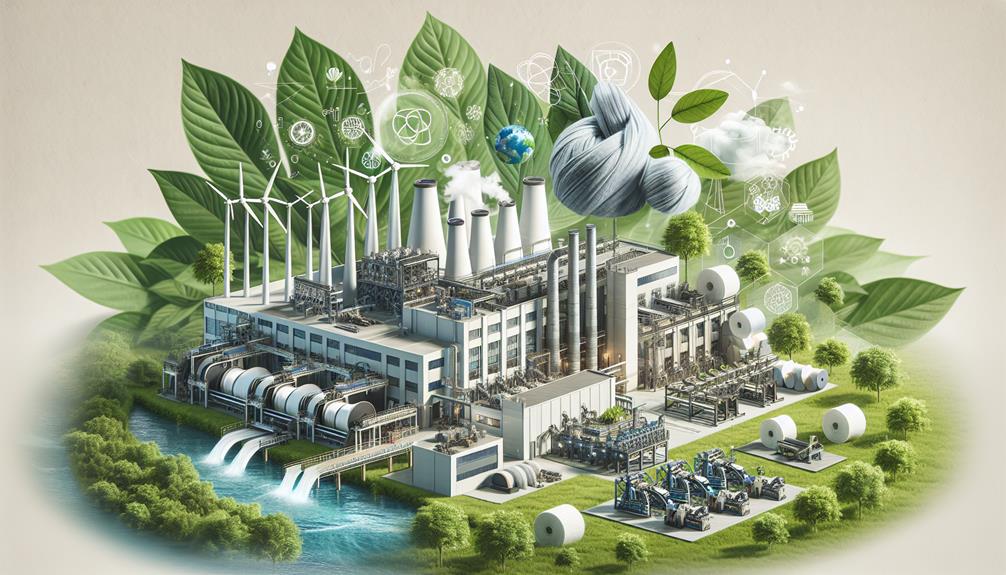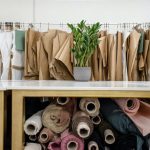I've found that Tencel Lyocell is definitely a good fabric choice. It's made from sustainable wood pulp in a closed-loop process, which hugely minimizes environmental impact. It's not just about being green; this fabric also offers superior comfort. It's soft, breathable, and excellent at wicking moisture away, making it great for different climates. Plus, it's strong and durable, outlasting many traditional fabrics. Tencel Lyocell is also easy to care for, needing only gentle washing and low-heat ironing. If you're looking for an eco-friendly option, this is it. Stick around, I've got even more insights on its benefits and future potential.
Table of Contents
Key Takeaways
- Tencel Lyocell is highly sustainable, utilizing a closed-loop system that minimizes environmental waste.
- It is made from sustainably sourced wood pulp, enhancing its eco-friendly profile.
- Offers superior comfort with its soft texture, breathability, and moisture-wicking properties.
- Known for its durability and strength, making it a long-lasting fabric choice.
- Tencel Lyocell's production process uses significantly less water and energy compared to conventional fabrics.
What Is Tencel Lyocell?
Tencel Lyocell is a sustainable fabric made from wood pulp, offering both environmental benefits and comfort. What strikes me most about this material is how it stands out in the fashion industry, not just for its eco-friendly production process, but also for its impressive functional qualities.
Derived from sustainably sourced wood fibers, Tencel is a testament to how fashion can indeed harmonize with nature. The wood fibers are transformed into a soft, luxurious fabric that feels incredible against the skin. It's this soft texture that makes Tencel a favorite for those of us who value comfort without compromising on style. Moreover, its breathability and moisture-wicking properties make it an ideal choice for activewear, underwear, and even bedding.
But it's not just about comfort; the strength and durability of Tencel Lyocell fibers contribute significantly to enhancing the structure and longevity of the fabrics. This means I'm investing in pieces that not only look and feel good but also last longer. Plus, the closed-loop production system used to create Tencel ensures minimal waste and chemical usage, aligning with my preference for products that are as kind to the earth as they're to my wardrobe.
Production Process and Sustainability
I'm impressed by how the production process of Tencel Lyocell prioritizes sustainability, using a closed-loop system that minimizes waste and environmental impact. This environmentally friendly method recycles water and reuses solvents at a rate of over 99%, drastically reducing harmful emissions and conserving resources. It's a sharp contrast to traditional textile manufacturing, which often involves significant waste and pollution.
The fibers themselves are sourced from sustainably managed forests where eucalyptus trees are grown. These trees don't require irrigation or pesticides, which means their cultivation has a low environmental footprint. This sustainable sourcing is crucial, not only for reducing deforestation but also for maintaining biodiversity. Moreover, the wood from these trees is transformed into soft, durable fibers through an eco-conscious process that demands less water and energy than conventional materials like cotton.
Another standout feature of the Tencel Lyocell production process is the incorporation of REFIBRA technology, which utilizes recycled cotton scraps. This addition enhances the sustainability of the fibers, pushing the fabric towards a circular economy model where waste is significantly reduced. It's clear that Tencel Lyocell isn't just another fabric; it represents a significant step forward in the sustainable textile industry.
Tencel Vs. Other Fabrics
Let's compare Tencel lyocell with other popular fabrics to see why it's becoming a favorite among eco-conscious consumers. First off, when you stack it against traditional cotton, the differences in sustainability are pretty stark. Cotton, while natural, often demands a hefty amount of water and pesticides. Tencel, on the other hand, is derived from wood pulp, primarily sourced from eucalyptus trees, which are far less thirsty and don't require pesticide-laden cultivation.
Now, moving over to other rayon fabrics, Tencel really shines. Most types of rayon, although made from plant material, can be harsh on the environment due to the chemicals used in their production. Tencel's production process is different. It uses a closed-loop system that recycles almost all of the chemicals and water it uses. This significantly reduces its environmental impact.
Besides just the sustainable angle, Tencel outperforms many fabrics in terms of functionality. It's not only soft and durable but also excels in moisture-wicking and breathability, making it ideal for both hot and cold climates. So, it's not just about being kind to the planet; it's also about superior comfort and practicality.
Benefits of Tencel Fabric
Exploring the benefits of Tencel fabric reveals its standout features: eco-friendliness, comfort, and durability. As a sustainable fabric made from wood pulp, Tencel stands out for its eco-friendly production process, which utilizes a closed-loop system. This means almost all solvents and water used are recycled, minimizing environmental impact.
What really draws me in is the natural comfort provided by Tencel. It's not just soft; it's also breathable and boasts excellent moisture-wicking properties, keeping me dry and comfortable throughout the day. For those of us with sensitive skin or who prioritize comfort, Tencel is a godsend.
Furthermore, the durability of Tencel means it's not just a purchase but an investment in quality clothing that lasts. Here's a table that contrasts the emotional and practical benefits of Tencel:
| Emotional Benefit | Practical Benefit |
|---|---|
| Soothing natural comfort | Strong moisture-wicking |
| Peace of mind from eco-friendly choices | Long-lasting durability |
| Connection to nature through renewable sourcing | Minimal environmental impact from closed-loop production |
Caring for Tencel Clothing
Now that we've looked at the benefits of Tencel fabric, let's talk about how to take care of it.
I'll show you how to wash, dry, and iron your Tencel garments to keep them looking their best.
It's not hard, but there are a few key things to remember to ensure your clothes last longer and stay in great shape.
Washing Tencel Garments Properly
To keep your Tencel garments looking their best, always wash them in cold water on a gentle cycle. This technique helps maintain the fabric's quality and durability, ensuring your clothes last longer and continue to feel soft.
Here's a list to guide you in washing Tencel properly:
- Use a mild detergent; harsh chemicals can damage the fibers.
- Avoid bleach to preserve color and texture.
- Turn clothes inside out to reduce abrasion.
- Opt for a low-spin cycle to minimize stress on the fabric.
- Group similar fabrics together in the wash to prevent rougher materials from causing pilling on your Tencel garments.
Drying Techniques for Tencel
After washing your Tencel garments properly, it's important to dry them correctly to keep them in top shape. Here's a straightforward guide:
| Technique | Setting | Benefit |
|---|---|---|
| Air-dried | None | Preserves softness, reduces wrinkles |
| Tumble-dried | Low heat | Minimizes shrinkage |
| Hang to dry | N/A | Maintains shape and quality |
Choose air-drying to prevent any heat damage and maintain the fabric's smooth texture. If you must use a dryer, always opt for a low setting. Remember to gently reshape Tencel while it's still damp to keep its original fit and drape. By following these techniques, you'll ensure your Tencel stays pristine.
Ironing Tencel Clothing Safely
Ironing Tencel clothing safely enhances its smooth appearance and maintains its quality. As a fabric born from a sustainable and eco-friendly production process, it's crucial to care for it properly to preserve both its aesthetic and functional benefits.
Here are some tailored ironing techniques:
- Low Heat Setting: Start with a low to medium heat setting to protect the fibers.
- Press Cloth Barrier: Use a thin cotton press cloth to prevent direct contact with the iron.
- Gentle Pressure: Apply light pressure to avoid stretching or misshaping the garment.
- Steam for Wrinkles: Utilize the steam function to handle stubborn wrinkles while supporting moisture management.
- Hang Immediately: After ironing, hang the garment to ensure it retains its shape and softness.
Future Outlook on Tencel Usage
Looking ahead, Tencel lyocell shows great promise as a sustainable fabric choice in the fashion industry. Its sustainable attributes, including its lighter carbon footprint and environmentally responsible production, make it a standout in the realm of sustainable fashion. As a versatile fabric, it's gaining traction as an alternative to less eco-friendly materials, shaping a future where fashion meets ecological responsibility.
The current limitations in production capacity compared to traditional fabrics like cotton could mean higher costs. However, this might also drive innovation and growth within the industry, positioning Tencel as a key player in the market. As facilities increase, I expect to see Tencel being adopted more broadly, promoting sustainable production methods across the fashion sector.
Tencel's unique characteristics not only offer sustainability but also practical benefits such as durability and comfort, enhancing its appeal. This positions Tencel favorably against other materials, suggesting a bright future where Tencel could become a mainstream choice for both designers and consumers seeking sustainable solutions. In my view, embracing Tencel is a smart move for the fashion industry, aiming for a greener, more sustainable future.
Frequently Asked Questions
What Are the Disadvantages of Tencel?
Tencel's disadvantages include its tendency to wrinkle easily, potential for shrinkage with high heat, and need for special care. It's also pricier and less available compared to fabrics like cotton or polyester.
Is Tencel Lyocell Good Quality?
I've found Tencel Lyocell to be of excellent quality. It's durable, strong, and sustainably sourced, making it a top choice for both eco-conscious consumers and those seeking long-lasting, comfortable fabrics.
Does Tencel Lyocell Wrinkle Easily?
Tencel Lyocell doesn't wrinkle easily due to its moisture-wicking properties and ability to retain shape. It's naturally wrinkle-resistant, maintaining a neat appearance, which makes it ideal for low-maintenance, polished garments.
Is Tencel Fabric Better Than Cotton?
I'd say Tencel fabric outshines cotton in sustainability and comfort. It uses less water, absorbs moisture better, and even incorporates recycled materials, making it a top choice for eco-conscious consumers.
- Is Tencel Lyocell a Good Fabric? - April 19, 2024
- What Are the 3 Main Properties of Nylon? - April 19, 2024
- What Is Nylon Fabric Made From? - April 19, 2024






